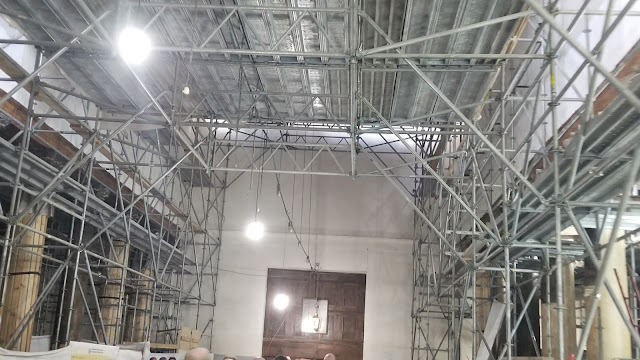 |
| Our group in front of the Basilica of the Nativity |
Bayt Sahour
Bayt Sahur (Arabic, بيت ساحور) is a largely Christian town whose name may meaning something like "House of the Night Watches.," which is appropriate given that somewhere near here would have been where the shepherds were "abiding with their flocks by night" when the angle of the Lord announced the birth of Jesus.
 |
| The hilly countryside north of Bethlehem where the angels sang of Jesus' birth |
The site we stopped at is Khirbet Siyar el-Ghanem, the Roman Catholic site that is operated by the Franciscans. An alternative site, Kanisat al-Ruwat, is operated by the Greek Orthodox Church, and both sites include Byzantine ruins. Before visiting the modern church, which was designed to look like a shepherd's tent and is decorated with beautiful paintings about the Annunciation to the Shepherds, we gathered in a meeting area overlooking some open hillsides. There I spoke about the Infancy Narratives, and we read from Luke 2 and sang "Angels We Have Heard on High."
 |
| The modern church looks somewhat like a Shepherd's tent |
Church of the Nativity
Early Christians venerated a series of caves in the hillside of Bethlehem as the place of Jesus' birth. Sometime around A.D. 135, the emperor Hadrian built a temple to Tammuz, the pagan god of food, as part of his wider effort to obliterate Jewish and Christian holy sites following the unsuccessful Second Jewish Revolt of A.D. 132-136. Some two hundred years later, Constantine allowed his mother Helena to raze the pagan temple and build a large Christian basilica. This was destroyed in one of the Samaritan Revolts of the mid-500's.
The Byzantine emperor Justinian built the current structure in A.D. 565, making it one of the oldest, continuingly used Christian churches in the world. According to one story, it survived the Persian invasion of A.D. 614 because the Persians were moved by depictions of the Magi within the church dressed as Persians. It survived Muslim rule, Crusader, usurpation, and the vicissitudes of time. However, much needed renovation revealed an interior completely filled with scaffolding when we entered it.
 |
| The interior of the Basilica of the Nativity Christmas Eve 2011 (with my mother, niece, and the back of my son Samuiel's head) |
While this kind of shrine is unfamiliar, even uncomfortable, to some Protestants and most Latter-day Saints, we need to remember that the Grotto of the Nativity is only one cave in a series throughout the hillside, and Jesus could have been born in any of them. Fortunately, several of them lie under the Roman Catholic Church of St. Catherine, and these are less ornamented and give a better feel for what a cave used as a stable might have been like.

The Tent Restaurant
Before leaving Bethlehem, we stopped and had a mixed grill, traditional Arab meal at the tent restaurant.
Israel Museum
After we crossed back into Israel, we went to the Israel Museum. While a few hours are hardly sufficient for such a great museum, we were able to enjoy the famous model of Jerusalem shortly before the outbreak of the First Jewish Revolt in A.D. 66, visit the Shrine of the Book, where the Dead Sea Scrolls are housed, and visit some of the archaeological exhibitions inside.




























No comments:
Post a Comment